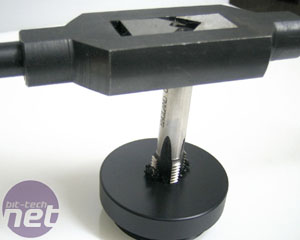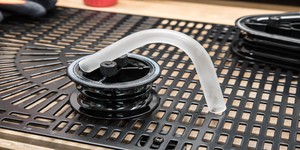
Fittings
Last, but certainly not least, are the connections between the tubing and your other parts. This is the area that you'd best read, re-read, and check again as I will cover things from a level of failure perspective. Clamping and connections are the most likely part of a setup to fail, and nine times out of ten it's due to improper installation.Most fittings come with a standard thread, which makes them largely interchangeable. This is very handy, as you may want different fittings than come with your setup. Each also comes in a size, which is discussed on the next page in more detail. When attaching fittings, it is very important to use proper sealants like plumbers' tape, silicone sealants, O-rings, or some combination of. This assures a tight, leak-proof seal that will last for years.
In order of failure rate from most to least:
- Barbs/clamps - This connection method, which can be either neoprene or metal, consists of a fluted barb which the tubing is forced over. Each flute is slightly wider than the tube's normal inner diameter, and so it creates a seal which is held in place by plastic or metal clamps.
Reasons for failure - clamps not tightened enough, tubing gets tugged, tubing cracks, plastic fittings crack.

Metaversa: Heavy Angel by Nexxo is one
of the best examples of compression fittings.
The fittings, by Python, cost over $50USD each. - Push-to-Connect (PtC) - PtC fittings are far more reliable than barbs and are easy to connect or disconnect (hence often being known as "quick connect" fittings). They consist of a largely metal fitting with a plastic inner "collar" where the tubing snaps into. They are most prevalent in smaller sizes, and as such they are very popular among low-flow enthusiasts.
Reasons for failure - After too many tubing changes, the plastic collar no longer snaps as firmly, making it hard to tell if it is in place.
- Compression - Compression fittings are a combination of a barb and a PtC fitting - the tube is forced over a barb, and a metal collar is then screwed down over the tube. The collar is slightly smaller diameter than the outer tube, making an airtight seal. As the collar is screwed down, the tubing is "compressed" tightly. Once on, you have to want to remove it - which you can do almost effortlessly. They are some of the most expensive fittings, but come in a variety of sizes and even some different levels of "bling."
Reasons for failure - You'd just have to be an idiot. I'd love to hear one that doesn't involve two dogs, six martinis and a shotgun.
- Self-seal - Self-seal fittings are laboratory grade fittings that function very similarly to an air compressor. When attached, they allow flow through - but the minute the collar is tugged, the whole joint seals up from both sides and the fittings can be disconnected without ever needing to drain the system. Even more conveniently, these are usually spliced into tubing runs rather than on a block, so they are easily able to migrate if you change something. Fantastic for people who change components around or move regularly, but well beyond the range of affordable for most people.
Reasons for failure - Never getting used because they're too expensive. Otherwise, look above and add at least one more dog.
So...a needle pulling thread?

Paul taps a reservoir top for
G1/4 fittings by hand.
G1/4 is actually a shorthand term for a specific combination of measurements - a particular count of BSP 1/4" threads. That is the standard thread on pretty much every pump, radiator, reservoir, etc. that is out on the market.
Note that I say "standard" and not "only." Are there exceptions? Of course. But, that's where this handy thread tapping guide from Paul comes in. With a bit of care, you can make anything fit G1/4 threads, and from that size there is an adapter to just about anything else (including things like the PtC fittings we just discussed).
The great thing is, the premise of tapping is the same no matter what the product or material. The guide is demonstrated on plastic, but would work on acrylic, metal, and anything else you fancy as well. It's a great way to make non-standard parts into something a bit more usable, or even better - turn something that was never intended to be water cooling equipment into a unique reservoir!

MSI MPG Velox 100R Chassis Review
October 14 2021 | 15:04









Want to comment? Please log in.